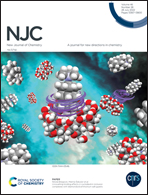In situ construction of a cobalt oxyhydroxide loaded pyrene-based fluorescent organic nanoprobe for bioimaging of endogenous ascorbic acid in living cells†
Abstract
Fluorescent organic nanoparticles (FONs) with intriguing features have emerged as a kind of inspiring contrast reagent for various biomedical applications. However, the formation of preassembled nanoparticles requires stimuli (such as light, pH, heat, etc.), which hampers their application in all circumstances. The challenge lies in understanding and then exploring a simple and feasible method to prepare FONs without any external stimuli. Herein, we designed a novel in situ strategy to fabricate cobalt oxyhydroxide (CoOOH) nanoflake-loaded pyrene-based fluorescent organic nanoparticles (PyFONs), enabling sensitive monitoring and precision imaging of ascorbic acid (AA) in living cells. The pyrene-based FONs were constructed via a facile one-step co-precipitation method and used as the signal output. The π–π stacking-directed self-assembly process provides a brightness at 468 nm of the pyrene excimer emission accompanied by an almost disappeared monomer peak around 370–400 nm. The CoOOH nanoflakes were then in situ grown on the surface of PyFONs to serve as both an effective quencher and a recognition unit for AA. The as-synthesized PyFONs@CoOOH showed weak fluorescence signals via Förster resonance energy transfer (FRET). Subsequently, the turn-on fluorescence responses were triggered during CoOOH nanoflake reduction to Co2+ by AA, which resulted in the decomposition and collapse of the CoOOH nanoflakes. Owing to the specific oxidation–reduction reaction between the enediol group of AA and CoOOH on the surface of the PyFONs@CoOOH nanoprobe, excellent sensitivity and selectivity for AA detection was obtained with a wide linear relationship from 2.0 μM to 500 μM. The detection limit was calculated to be as low as 0.21 μM (S/N = 3). More importantly, the PyFONs@CoOOH nanoprobe also presented excellent sensitivity and selectivity for AA analysis in biological fluids, as well as for bioimaging of endogenous AA in living cells. Consequently, the proposed sensing systems can serve as a powerful tool to monitor and image AA and show broad potential applications in clinical diagnostics and drug screening.



 Please wait while we load your content...
Please wait while we load your content...